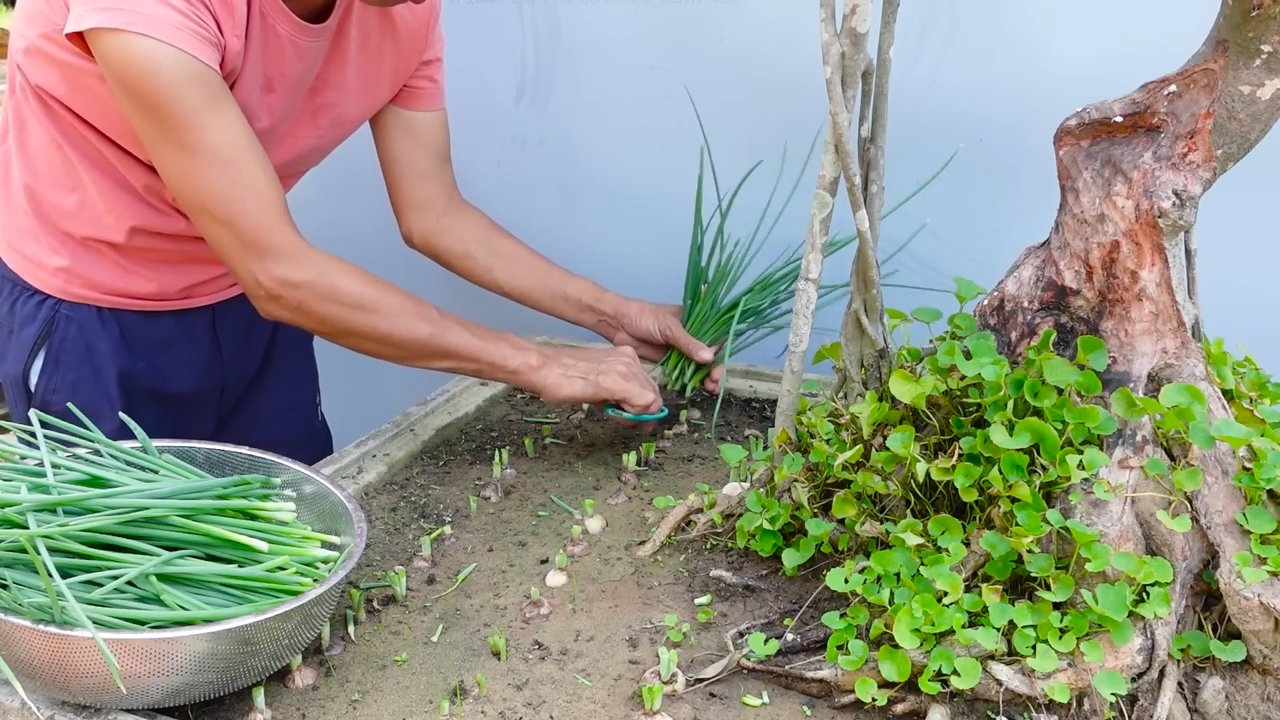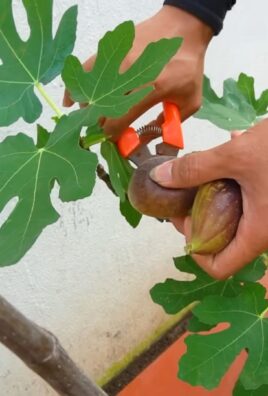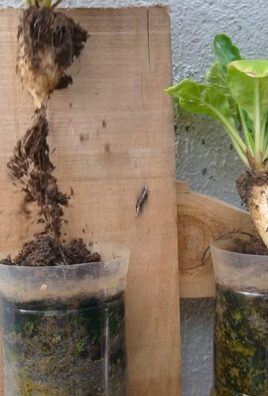Growing Green Onions Compactly is easier than you might think, and I’m so excited to share some simple DIY tricks that will transform your small space into a thriving green onion haven! Forget those expensive grocery store bunches that wilt in a week. Imagine snipping fresh, flavorful green onions right from your windowsill whenever you need them.
For centuries, cultures around the globe have cultivated green onions, also known as scallions, for their culinary and medicinal properties. From Asian stir-fries to European salads, these versatile plants have added a zesty kick to countless dishes. But you don’t need acres of land to enjoy this kitchen staple.
In today’s world, where space is often a premium, and the desire for fresh, homegrown produce is on the rise, mastering the art of growing green onions compactly is more relevant than ever. This DIY guide will provide you with easy-to-follow steps and clever hacks to maximize your yield, even if you only have a small balcony, patio, or even just a sunny windowsill. Say goodbye to wasted money and hello to a constant supply of fresh, delicious green onions!

Growing Green Onions Indoors: A Space-Saving DIY Guide
Hey there, fellow plant enthusiasts! Are you craving fresh green onions but short on garden space? Or maybe you just want a constant supply right at your fingertips, no matter the weather? Well, you’re in the right place! I’m going to walk you through a super easy and rewarding DIY project: growing green onions indoors, compactly. This method is perfect for apartment dwellers, small kitchens, or anyone who wants a little bit of green in their life.
What You’ll Need
Before we dive in, let’s gather our supplies. The beauty of this project is that it’s incredibly budget-friendly and uses materials you probably already have around the house.
* **Green Onions:** Obviously! You can use store-bought green onions. Look for ones with healthy, intact roots. The more roots, the better!
* **A Container:** This could be anything from a mason jar to a plastic container to an old coffee mug. Just make sure it’s clean and can hold water. I personally love using glass jars so I can see the roots growing.
* **Water:** Tap water is fine, but filtered water is even better.
* **Optional: Small Pebbles or Gravel:** These can help weigh down the green onions and keep them upright, especially if your container is tall and narrow.
* **Optional: Liquid Fertilizer (Balanced):** A diluted liquid fertilizer can give your green onions a boost, but it’s not essential.
* **Scissors or a Knife:** For harvesting your green onions.
Step-by-Step Instructions: Regrowing Green Onions from Scraps
This is where the magic happens! Follow these steps, and you’ll be enjoying fresh green onions in no time.
1. **Prepare the Green Onions:** Take your bunch of green onions and cut off the green tops, leaving about 1-2 inches of the white base with the roots attached. Don’t throw away the green tops! You can use them in your cooking right away. This is all about reducing waste and maximizing flavor!
2. **Prepare Your Container:** Clean your chosen container thoroughly with soap and water. If you’re using pebbles or gravel, add a layer to the bottom of the container. This will help with drainage and stability.
3. **Add Water:** Fill the container with enough water to cover the roots of the green onions, but don’t submerge the entire white base. You want the roots to be in the water, but the base to be mostly above it to prevent rotting.
4. **Place the Green Onion Scraps:** Carefully place the green onion scraps, root-end down, into the container of water. If you’re using a wide-mouthed container, you can fit several scraps in at once, just make sure they have enough space to grow.
5. **Find a Sunny Spot:** Place your container in a bright, sunny location. A windowsill is ideal. Green onions need plenty of sunlight to thrive. If you don’t have a sunny spot, you can use a grow light.
6. **Change the Water Regularly:** This is crucial! Change the water every 1-2 days to prevent bacteria growth and keep the water fresh. This will also help prevent the green onions from developing a slimy texture.
7. **Observe and Enjoy:** Watch your green onions grow! You should start to see new green shoots emerging within a few days. It’s so satisfying to see them come back to life.
8. **Optional: Fertilize:** If you want to give your green onions a boost, you can add a diluted liquid fertilizer to the water every couple of weeks. Follow the instructions on the fertilizer packaging for proper dilution. I usually use a balanced fertilizer (like 10-10-10) at half strength.
Harvesting Your Green Onions
Now for the best part: enjoying the fruits (or rather, vegetables) of your labor!
1. **Harvest When Ready:** Once your green onions have grown to a desired length (usually around 6-8 inches), you can start harvesting.
2. **Cut and Enjoy:** Use scissors or a knife to cut off the green tops, leaving about 1-2 inches of the base intact. This will allow the green onions to continue to regrow.
3. **Use Immediately or Store:** Use your freshly harvested green onions immediately in your cooking, or store them in the refrigerator for later use. I like to wrap them in a damp paper towel and store them in a plastic bag to keep them fresh.
Troubleshooting and Tips
Even with the simplest projects, sometimes things don’t go exactly as planned. Here are a few common issues you might encounter and how to fix them:
* **Green Onions Turning Yellow:** This could be a sign of overwatering, lack of sunlight, or nutrient deficiency. Make sure you’re changing the water regularly, providing enough sunlight, and consider adding a diluted fertilizer.
* **Green Onions Rotting:** This is usually caused by keeping the base of the green onion submerged in water for too long. Make sure only the roots are in the water.
* **Slow Growth:** This could be due to lack of sunlight or nutrients. Try moving your container to a sunnier location or adding a diluted fertilizer.
* **Slimy Texture:** This is a sign of bacteria growth in the water. Change the water more frequently.
Tips for Success
* Start with Healthy Green Onions: The healthier the green onions you start with, the better the chances of success. Look for ones with firm, white bases and healthy roots.
* Use Clean Water: Using clean water is essential for preventing bacteria growth.
* Provide Plenty of Sunlight: Green onions need plenty of sunlight to thrive.
* Don’t Overcrowd: Give your green onions enough space to grow.
* Be Patient: It takes time for green onions to regrow. Don’t get discouraged if you don’t see results immediately.
* Experiment with Different Containers: Try different containers to see what works best for you.
* Consider Soil: While this guide focuses on growing green onions in water, you can also grow them in soil. Simply plant the green onion scraps in a small pot of soil, making sure to keep the soil moist.
* Successive Planting: To ensure a continuous supply of green onions, start new batches every few weeks. This way, you’ll always have fresh green onions on hand.
Beyond the Basics: Expanding Your Green Onion Growing
Once you’ve mastered the basics of regrowing green onions in water, you can explore some more advanced techniques.
* **Hydroponics:** You can adapt this method to a simple hydroponic system. This involves using a nutrient-rich water solution and an air pump to provide oxygen to the roots.
* **Aquaponics:** If you have a fish tank, you can use the nutrient-rich water from the tank to grow your green onions. This is a great way to recycle nutrients and create a symbiotic relationship between your plants and fish.
* **Companion Planting:** Green onions are great companion plants for many vegetables, such as tomatoes, peppers, and cabbage. They help to repel pests and improve the flavor of these vegetables.
Why I Love This DIY Project
I absolutely love this DIY project because it’s so simple, rewarding, and sustainable. It’s a great way to reduce food waste, save money, and enjoy fresh, homegrown green onions all year round. Plus, it’s just plain fun to watch them grow! I hope you give it a try and experience the joy of growing your own food. Happy gardening!
Conclusion
So, there you have it! Growing green onions compactly isn’t just a gardening hack; it’s a game-changer for anyone who loves fresh, flavorful ingredients at their fingertips. We’ve walked through the simple steps, highlighting how easy it is to transform those leftover green onion scraps into a thriving, space-saving garden. Forget those wilting bunches from the grocery store – imagine snipping vibrant, crisp green onions whenever you need them, adding a burst of freshness to your omelets, salads, stir-fries, or even as a garnish for your favorite tacos.
This method is a must-try for several compelling reasons. First, it’s incredibly economical. You’re essentially recycling food waste and turning it into a valuable resource. Second, it’s remarkably convenient. No more last-minute trips to the store when you realize you’re out of green onions. Third, it’s surprisingly rewarding. There’s something deeply satisfying about nurturing a plant from a tiny scrap and watching it flourish. And finally, it’s perfect for small spaces. Whether you have a sprawling garden or just a sunny windowsill, you can successfully grow green onions compactly.
But don’t stop there! Experiment with different containers. Try using repurposed yogurt containers, plastic bottles cut in half, or even an old colander lined with fabric. You can also explore different soil mixes. While a standard potting mix works well, you might want to add some compost or perlite to improve drainage and aeration. Consider adding a slow-release fertilizer to the soil to provide your green onions with a steady supply of nutrients.
For a fun variation, try growing different varieties of green onions. There are several types available, each with its own unique flavor and texture. Some are milder, while others have a more pungent bite. Experiment to find your favorites! You can also try interplanting your green onions with other herbs, such as basil or parsley, to create a miniature herb garden.
We wholeheartedly encourage you to give this DIY trick a try. It’s easy, affordable, and incredibly rewarding. Plus, it’s a great way to reduce food waste and connect with nature. Once you experience the joy of harvesting your own fresh green onions, you’ll never look at those leftover scraps the same way again.
Don’t be shy! Share your experiences with us. We’d love to hear about your successes, your challenges, and any variations you’ve tried. Post photos of your thriving green onion gardens on social media using #CompactGreenOnions and tag us so we can see your amazing results. Let’s create a community of green onion enthusiasts and inspire others to embrace this simple yet effective gardening technique. Happy growing!
Frequently Asked Questions (FAQ)
What kind of green onions work best for regrowing?
Almost any type of green onion will work for regrowing, but the most common varieties found in grocery stores, such as scallions, are ideal. Look for bunches with healthy, firm white bulbs and vibrant green tops. Avoid any that are wilted, slimy, or have signs of rot. The healthier the starting material, the better your chances of success.
How much of the green onion should I leave when cutting off the tops for cooking?
Leave at least 1-2 inches of the white bulb and the very bottom of the green stalks attached. This is where the roots will emerge, so it’s crucial to have enough of the bulb intact. Cutting too close to the roots can prevent regrowth.
What kind of soil is best for growing green onions compactly?
A well-draining potting mix is ideal. You can use a standard potting mix from your local garden center. To improve drainage and aeration, consider adding perlite or vermiculite to the mix. You can also amend the soil with compost to provide additional nutrients. Avoid using heavy clay soil, as it can become waterlogged and hinder root growth.
How often should I water my regrowing green onions?
Keep the soil consistently moist, but not soggy. Water when the top inch of soil feels dry to the touch. Overwatering can lead to root rot, so it’s important to ensure good drainage. During warmer months, you may need to water more frequently. Check the soil moisture regularly and adjust your watering schedule accordingly.
How much sunlight do green onions need?
Green onions thrive in full sun, which means at least 6 hours of direct sunlight per day. However, they can also tolerate partial shade, especially during the hottest part of the day. If you’re growing your green onions indoors, place them near a sunny window or use a grow light to supplement natural light. Insufficient sunlight can result in leggy growth and reduced flavor.
How long does it take for green onions to regrow?
You should start to see new growth within a few days of planting the green onion bulbs. Within a week or two, you’ll have enough green onions to start harvesting. The rate of growth will depend on factors such as sunlight, temperature, and soil fertility.
How do I harvest my regrown green onions?
Simply snip off the green stalks with scissors, leaving about an inch of the bulb intact. This will allow the green onions to continue to regrow. Harvest only what you need, and the plant will continue to produce new growth.
Can I grow green onions in water only?
Yes, you can initially regrow green onions in water. Place the bulb in a glass or jar with enough water to cover the roots. Change the water every day or two to prevent bacterial growth. Once the roots have grown a few inches, you can transplant the green onions into soil for continued growth and better flavor. Growing in soil provides the plants with essential nutrients that they won’t get from water alone.
How often can I harvest from the same green onion bulb?
You can harvest from the same green onion bulb multiple times, but eventually, the bulb will become exhausted. After several harvests, the growth rate may slow down, and the flavor may become less intense. At this point, it’s best to start with fresh green onion bulbs.
Can I grow green onions indoors year-round?
Yes, you can grow green onions indoors year-round, as long as you provide them with adequate light and water. Place them near a sunny window or use a grow light. Maintain a consistent watering schedule and fertilize them regularly to ensure healthy growth.
What are some common problems when growing green onions and how do I fix them?
Some common problems include yellowing leaves, which can be caused by overwatering or nutrient deficiencies. Ensure proper drainage and fertilize with a balanced fertilizer. Pests, such as aphids, can also be a problem. Wash them off with a strong stream of water or use insecticidal soap. Root rot can occur if the soil is too wet. Ensure good drainage and avoid overwatering.
Can I use fertilizer to help my green onions grow?
Yes, fertilizing your green onions can help them grow faster and produce more flavorful greens. Use a balanced fertilizer, such as a 10-10-10, diluted to half strength. Apply the fertilizer every few weeks during the growing season. Avoid over-fertilizing, as this can burn the roots.
Is it better to grow green onions from seed or regrow them from scraps?
Regrowing green onions from scraps is a faster and easier way to get a harvest. Growing from seed takes longer and requires more effort. However, growing from seed allows you to choose from a wider variety of green onion types. Both methods have their advantages, so it depends on your preferences and goals.
How do I prevent my green onions from bolting (flowering)?
Bolting is when a plant prematurely flowers, which can affect the flavor of the leaves. To prevent bolting, keep your green onions well-watered and avoid exposing them to extreme temperatures. Harvest regularly to encourage vegetative growth. If your green onions do bolt, you can still eat the flowers, but the leaves may become tougher and more bitter.




Leave a Comment